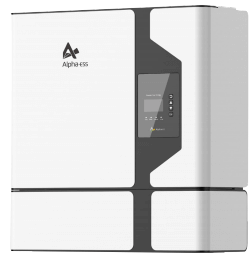Home Solar Battery Storage How many solar batteries do I need?
How many solar batteries do I need?
The quantity of solar batteries required hinges on your system’s capacity, your electricity usage, and your objectives for the battery setup.
The solar battery you will most likely need is a 14kWh which comes as a single unit. It is by far the most popular size and suits solar systems 5 – 6.6kW in size. This will be sufficient power to run your home while the sun is not shining.
If you want to go off-grid, you will need a 4 – 5 times bigger battery to account for cloudy and rainy days where power harvested from panels is reduced.
Table of Contents
ToggleSizing your solar battery system
Sizing your solar battery system is the process through which you calculate the size of batteries you require for the storage of power on your system. Through this, you are able to compare your power requirements with your solar panels and days of power storage and come up with the right battery capacity required.
The process of sizing your solar battery system is affected by the amount of consumption at your home, the number of days you would like to store your energy, and the type of batteries you get.
You have to make sure you have enough batteries for your energy needs and the type of batteries that can be charged by your solar panels.
STEP 1
The first step is calculating the total energy consumption at your home. If you already have a system installed, you can skip stepping 2.
You will need to look at your power bill and work out the average power used by your home daily. If it is a monthly bill, take the kiloWatt hours and divide by 30 to get a single-day usage.
STEP 2
The second step is calculating the best battery size for that energy.
Let’s say, for example, you have a daily usage of 20kWh on average. This is great for a 5kWh solar system that produces that amount of power each day.
Because we use 60-70% of our power at night, we need to store 70% of the power the system produces for later use.
20kW X .07 = 14kW
For this example, a standard size 14.4kWh battery like the Tesla Powerwall 2 or the SonnanBattery will do the job.
Which type of battery should I go for?
Currently, you have 2 x realistic options for a Lead acid battery similar to the ones you find in your car. Or a Lithium-ion battery.
Lead Acid Battery
When calculating the size of the lead-acid battery, we have to consider that there is a 50% discharge depth. Hence you multiply by 2. Then you have to account for the inefficiency factor, which is 1.2.
That is, 10 kWh x 2 x 1.2 = 24 kWh.
You will need double capacity. It’s worth noting that lead-acid battery technology is over 100 years old and has limitations. It is quite cheap to get set up, though.
That being said, they only last about half as long as Lithium-ion batteries, so it’s not worth it.
Lithium Battery
Lithium-ion batteries have a 10-year warranty and will last longer than that. Unlike their lead-acid counterparts, they have a discharge depth of 80% + and require very little to no maintenance.
Lithium-ion is the way to go as they are smaller, last longer, and is more efficient. You will pay double, but they last more than twice as long at greater efficiency.
Solar battery calculator
The solar battery calculator is designed to help you understand how many batteries you need for your solar system. This is because each solar system has a specified number of batteries it should be able to charge.
By using a solar battery calculator, you can precisely know how many batteries to buy for what system to avoid wastage of money.
Number of batteries by solar system size
Getting the exact number of batteries you need for a solar system is determined by the type of batteries you are using and how many days you want the energy stored. It also depends on the amount of energy you would like to store. The depletion depth is also a major factor in this case.
3kw – Energy output, in this case, is 12 kWh. A battery with 8.4 kWh will be required.
4kw – Energy production here is 16 kWh per day. This means that you need a battery that is able to 11.2 kWh.
5kw – Makes 20 kWh per day. Since a home will require around 70% solar power at night and 30% during the day. A battery of 14 kWh, in this case, is ideal.
6kw – This system makes 24 kWh per day. Meaning for a 6kW system with a battery, you’ll need a battery with a capacity of 14 – 18kWh.
10kw – It is a system making 40 kWh of power per day. As a result, one will need a battery with a capacity of at least 28 kWh.
11kW – This will generate from 41 – 56kW daily, so for storage of a grid-tied system, you’ll need a 33kW battery.
30kw – The total output here is 120 kWh per day. This means that you will need batteries with a capacity of 84 kWh. However, if you do not find a single battery that can generate this amount of power, it is okay to have several. In the case of Tesla Powerwall 2 storing 14 kWh, you need 6 batteries.
100kw – For a 100kw system, the total energy output is 400 kWh per day. This means you will need a battery that can store up to 280 kWh when using Tesla Powerwall 2 with a capacity of 114 kWh, that is 20 batteries.
Note that most suppliers allow for expandable steps.
The following are some key things to note for such a system. When calculating the number of batteries, you must consider the voltage required or selection since it affects efficiency and cost in terms of cable sizes used. As a result, for any power system with a power of 3kWh, you need a voltage of 12v, between 3 and 5 kWh is 24v, and above 5 kWh is 48v.
Days of storage can also affect the batteries you need in your system.
Which is the best solar battery?
The best solar battery is a Lithium-ion battery.
| Battery | Cost | 14 kW | Cost per kW | Capacity | Warranty | Type |
|---|---|---|---|---|---|---|
| Alpha Ess | $7,302 | $9,346 | $668 | 10kWh | 10 years | Lithium Ion |
| Sungrow | $3,500 | $10,220 | $730 | 4.8 kWh | 10 years | Lithium Ion |
| Ampetus Energy | $2,300 | $10,580 | $756 | 3kWh | 15 years | Lithium-iron-phosphate |
| LG | $8,195 | $11,718 | $837 | 9.8kWh | 10 years | Lithium Ion |
| Soltaro 2 | $1,700 | $11,900 | $850 | 2kWh | 10 years | Lithium Ion |
| Aquion Energy | $2,200 | $12,320 | $880 | 2.5 kWh | 5 years | Salt Water |
| Sungrow-Samsung sbp4k8 | $4,610 | $13,461 | $962 | 4.8kWh | 10 years | Lithium ion |
| Tesla Powerwall 2 | $14,000 | $14,000 | $1,000 | 14kWh | 10 years | Lithium ion |
| ZEN Energy | $10,000 to $15,000 | $14,000 | $1,000 | 10kWh to 20kWh | 10 years | Lithium Ion |
| sonnenBatterie Eco | $15,000 | $15,000 | $1,071 | 14kWh | 10 years | Lithium ion |
| Fronius Solar Battery | $5,000 to $20,000 | $15,555 | $1,111 | 4.5kWh – 12.0kWh | 7 years | Lithium-ion phosphate |
| Redflow Zcell | $12,600 | $17,640 | $1,260 | 10kWh | 10 years | Zinc-bromine |
| Leclanche Apollion Cube | $9,200 | $19,320 | $1,380 | 6.7kWh | 10 years | Lithium ion |
| Simpliphi Batteries | $4,750 | $19,570 | $1,398 | 3.4kWh | 10 years | Lithium Ferrous Phosphate |
| Solax | $5,390 | $21,560 | $1,540 | 3.5kWh | 5 years | Lithium-ion |
| Magellan Power | $20,600 | $22,536 | $1,610 | 12.8 kWh | 5 years | Lithium ion |
| Enphase Energy | $2,057 | $23,998 | $1,714 | 1.2kWh | 10 years | Lithium Ion |
| AKASOL’s neeoQube | $12,000 | $30,000 | $2,143 | 5.5kWh | 10 years | Lithium Ion |
| Sunverge SIS | $26,000 | $31,200 | $2,229 | 11.6kWh | 10 years | Lithium Ion |
| Redback Technologies | $10,745 | $31,375 | $2,241 | 4.8kWh | 5 years | Lithium Ion |
| Hansol Technics | $13,500 | $37,800 | $2,700 | 4.98kWh | 5 years | Lithium ion |
When comparing batteries to find out the best, several factors are worth comparing to make sure that you know which is better.
That includes;
Depth of discharge
Depth of discharge is also referred to as DOD. Discharge depth is the amount of energy you should use on the battery when using it. This is because it is not advisable to use 100% of the charge on a battery.
As a result, different brand of batteries has various DOD. This means that a battery with a high DOD will allow you to use more energy on your battery than one with a low DOD.
Power and Capacity
The capacity basically refers to the amount of energy a battery can store. It is measured in kWh. As a result, different batteries have different capacities. A good battery can store more energy.
However, in this case, power also comes to play. When the capacity shows how big a battery is, its power rating shows how much power it can deliver at a given time.
This means a battery can have low capacity but a high rating on power. The result is that it can power a home comfortably but for a few hours.
A battery with a large capacity but a low rating on power, on the other hand, is able to power a small area but for several hours.
Battery life
Battery life and warranty refer to how long a battery can last. This can be in terms of years or cycles. A good battery is one with many cycles or a long lifespan. When looking at lifespan, lithium-ion batteries have the longest lifespan, followed by Saltwater batteries, then Lead Acid.
Round-trip efficiency
This is a question of how much you can derive from your battery compared to how much is fed in. Batteries use energy to store energy. As a result, you cannot get 100% energy you stored. You must consider this efficiency percentage when selecting a battery to get one with the most efficiency.
Based on the above factors, Lithium-ion batteries are the best compared to Lead-acid and Saltwater batteries. This is because they have a high DOD, and their lifespan is the longest.
Other advantages of Lithium-ion batteries include;
- No ventilation/off-gassing
- No maintenance is required
- Power usage is efficient
- Their storage capacity is better and more usable.
What is the cheapest solar battery?
Finding the cheapest solar battery is not easy since it depends on several factors. If we are talking battery type, then it’s anything lead-acid. But in the Lithium-ion space, the best bang for your buck is going to be the……
WINNER: Alpha Ess Smile5 – INV

| Battery | Size | Cost | Type |
|---|---|---|---|
| Alpha Ess Smile5-INV | 10kW | $9346 | Lithium-ion |
How long do solar batteries last?
Between 5 and 15 years.
The lifespan of solar batteries is affected by some factors. These factors include the type of battery, care, and maintenance.
A solar battery well maintained will last longer. Maintenance is mostly on Lead-acid batteries that have you regularly clean terminals of any corrosion, and avoid overcharging, among other maintenance procedures. Proper maintenance will extend its lifespan.
The type of battery is the next factor that affects the lifespan of a battery. In this case, you will find Lithium Batteries to have the longest lifespan followed by Saltwater batteries then Lead Acid batteries.
Lithium batteries- 10 to 15 years
Saltwater batteries- 8 to 10 years
Lead Acid batteries – 5 to 7 years.
Do I need a solar battery?
Solar batteries are not needed if you are using a solar feed-in tariff. You will need one or the other, as trying to run a house on solar panels alone will not work.
The reason is most households use 70% of their power at night. As solar panels generate 100% of their power throughout the day, there will be a large discrepancy between when power is produced and when it is used.
You will need to either store energy for later use in batteries or get credits from your local energy retailer and draw on the energy later.
Compare Solar Panel Quotes
Table of Contents
Toggle









